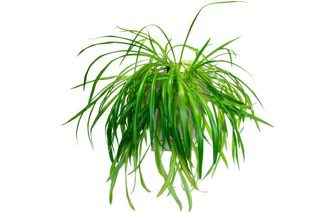
Spider plants are generally safe and not toxic to dogs. In fact, they have been known to have some health benefits for dogs as they can help improve air quality and reduce stress levels in dogs.
However, some dogs may experience minor stomach upset if they consume large quantities of the plant. The plant’s leaves and roots are not poisonous to dogs, but it’s always best to keep them out of reach to avoid any potential harm.
If your dog has eaten spider plant and shows any signs of vomiting, diarrhea, or lethargy, it’s best to contact your veterinarian immediately. As with any plant, it’s always important to monitor your dog’s behavior around them and take necessary precautions to ensure their safety.
The Spider plant is a popular houseplant known for its ability to survive in low light conditions and remove harmful toxins like benzene and formaldehyde from indoor air. It has long, slender leaves that arch from a central rosette and can produce delicate white flowers that turn into plantlets, making propagation easy. The Spider plant is a common choice for indoor spaces and outdoor landscapes in many regions around the world due to its air-cleaning properties, easy care, and unique appearance.
There are no common symptoms of dogs poisoning from spider plants, as they are generally safe and not toxic to dogs. However, some dogs may experience minor stomach upset if they consume large quantities of the plant.
The signs of spider plant toxicity may include vomiting, diarrhea, or lethargy. Behavioral changes may include decreased energy levels, loss of appetite, or reluctance to move.
Immediate actions to take if you suspect your dog has been exposed to spider plants are to contact your veterinarian immediately. If possible, try to identify the plant and bring a sample with you to your veterinarian’s office.
To prevent dogs from eating spider plants, it’s best to keep them out of reach or behind closed doors. It’s also important to monitor your dog’s behavior around plants and take necessary precautions to ensure their safety.
If your dog eats spider plants, it’s best to contact your veterinarian immediately. The leaves and roots of spider plants are not poisonous to dogs, but it’s still important to monitor your dog’s behavior and seek medical attention if necessary.
Do you own a spider plant or are you thinking about getting one? If so, be sure to check out our website Way Canina, where you can compare different house plants to see which are the best options for your dogs. While spider plants are generally safe and non-toxic to dogs, it’s important to keep them out of reach to avoid any potential harm. If your dog does consume any part of the plant and shows any signs of discomfort, be sure to contact your veterinarian immediately. Always monitor your dog’s behavior around plants and take necessary precautions to ensure their safety.
There are several other indoor plants that are safe and non-toxic for dogs, such as Boston ferns, African violets, and Christmas cactus. These plants are great options for dog owners who want to bring some greenery into their homes without posing a risk to their furry companions.
As for outdoor plants, it’s important to choose ones that are non-toxic and, if possible, avoid those that can be harmful to dogs when ingested. Some safe options include marigolds, roses, and petunias. It’s also a good idea to keep dogs away from plants like daffodils, lilies, and azaleas, which can be toxic to them.
We hope you found this information about spider plants and dogs helpful! Before we go, we wanted to remind you that Way Canina is always here to provide you with healthy food ideas for your furry friend and more information on their lifestyle. So even if you didn’t get the mentioned houseplant, we invite you to visit our site again. Thanks for reading and take care of your beloved pet!
The Spider plant (Chlorophytum comosum) is a popular houseplant native to South Africa. It is a member of the Asparagaceae family and is also commonly referred to as the Spider Ivy or the Airplane plant. The plant has long slender leaves that arch gracefully from a central rosette and produce delicate white flowers that give way to plantlets, which can easily propagate into new plants.
The Spider plant is a versatile plant that can be used both indoors and outdoors. Its ability to survive in low light conditions make it a popular choice for use in homes, offices and other indoor spaces. It is also commonly used in gardens and outdoor landscapes as a groundcover or hanging plant. The Spider plant prefers well-drained, lightly moist soil and can tolerate temperatures ranging from 60-75°F.
The Spider plant is popular in many regions around the world. In the United States, it is a common houseplant due to its easy care and air-cleaning properties. In Europe, it is often used as a trailing plant for hanging baskets and window boxes. In Asia, the Spider plant is prized for its traditional medicinal properties and is used in various herbal remedies.
People choose the Spider plant for a variety of reasons. Its ability to remove harmful toxins such as benzene and formaldehyde from indoor air makes it a popular choice for improving indoor air quality. It is also easy to care for and can thrive in a variety of environments, making it a low-maintenance plant that is perfect for those with busy lifestyles. Additionally, the Spider plant's unique appearance and ability to produce plantlets makes it a popular choice for both experienced and novice gardeners alike."